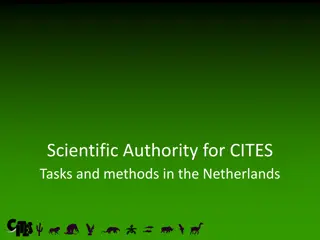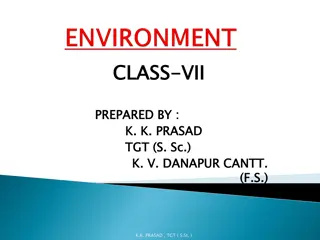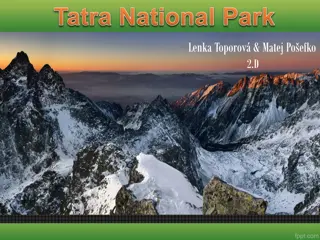The Fascinating World of Coral Reefs and Their Biodiversity
Coral reefs are vital biogenic structures formed by reef-building corals and various marine organisms. These ecosystems, found in diverse regions like the Caribbean, Indo-Pacific, Fiji, and Bermuda, host a rich array of flora and fauna, including corals, fish, turtles, and sea snakes. The intricate
5 views • 14 slides
Biodiversity Parks of Delhi: Oasis of Nature in the Urban Jungle
Delhi's Biodiversity Parks, including the Yamuna Biodiversity Park and Aravalli Biodiversity Park, are unique landscapes that serve as home to vanishing species, wetlands, grasslands, and medicinal herbs. These parks offer ecological, cultural, and educational benefits, representing a conservation s
4 views • 10 slides
Roheenaz Flora Unstitched Printed Lawn 2024 - Summer Fashion
Elevate your style with the Roheenaz Flora unstitched suit, featuring a beautifully printed lawn shirt with intricate organza embroidery on the neckline. Paired with a lightweight chiffon dupatta and comfortable dyed trousers, this suit offers a perfect blend of elegance and comfort, ideal for any o
1 views • 8 slides
Saona Island Excursion: Discover Paradise with Guided Snorkeling and Beaches
Saona Island Excursion takes you to an island environment with sandy beaches and crystal blue waters. Take a day excursion to immerse yourself in nature and a rich variety of flora and fauna on Saona Island. User friendly guided tours which one may e
3 views • 8 slides
Normal Flora of Human Body
Normal flora, comprising bacteria and fungi, are beneficial residents of specific body sites like the skin, colon, and vagina. These organisms, known as commensals, play a vital role in maintaining a healthy microbial balance. The internal organs are usually sterile, while different types of normal
2 views • 16 slides
Understanding Normal Flora of the Gastrointestinal Tract & Infectious Diarrhea
Normal flora in the gastrointestinal tract play a crucial role in maintaining health, but can also cause disease in certain conditions. This lecture covers the common flora in the GIT, their role in diseases, various types of acute diarrheal illnesses, epidemiology, and management of bacterial agent
1 views • 26 slides
Understanding Impact Prediction, Evaluation, and Mitigation
Impact prediction involves identifying the magnitude and significance of environmental changes due to a project or action. It is crucial to assess both direct and indirect effects on various aspects such as human beings, flora, fauna, geology, land, water, air, and climate. Evaluating these effects
1 views • 12 slides
Influential Educators: Joel D. Heck, Flora Hamilton Lewis, and Beatrix Potter
Explore the educational journeys of Joel D. Heck, Flora Hamilton Lewis, and Beatrix Potter, from their academic backgrounds to their deep thoughts on education and rhetoric. Discover the impact of influential figures like Harry Wakelyn Smith and the profound influence of MacDonald's book "Phantastes
1 views • 33 slides
Insights into the Siwaliks: Geography, Geology, and Climate
Siwaliks, part of the Himalayan range, hold a rich geological history with unique landscapes and diverse flora and fauna. Stretching from Bhutan to Pakistan, these mountains boast a variety of rock layers, surrounding rivers, and distinct climates. The region's straitigraphy and geology mark it as a
1 views • 34 slides
Understanding the Spoilage Flora in Raw Meat Products
Raw meat products are highly perishable due to the presence of various spoilage bacteria, yeasts, and molds. Factors such as nutrient availability, oxygen levels, storage temperature, and pH influence the predominant spoilage flora in meat. Psychrotrophic bacteria thrive in refrigerated storage, lea
0 views • 17 slides
Understanding the Normal Microbial Flora of the Human Body
The normal microbial flora, also known as the indigenous microbiota, inhabit various areas of the human body such as the gastrointestinal tract, respiratory tract, genitourinary tract, and skin. They play a crucial role in maintaining health and can re-establish themselves when disturbed. While resi
0 views • 22 slides
Understanding the Normal Flora of the Gastrointestinal Tract and Infectious Diarrhea
Explore the common normal flora of the gastrointestinal tract (GIT) and how they play a role in health and disease, specifically focusing on infectious diarrhea. Learn about different types of acute diarrheal illnesses, epidemiology, host defenses against GI infections, and the pathogenesis of bacte
0 views • 38 slides
Understanding the Diversity of Microorganisms in Soil Ecosystems
Microorganisms in soil play crucial roles in soil fertility, nutrient cycling, and industrial product synthesis. They can also be pathogens causing diseases in plants and humans. Soil organisms are broadly classified into two groups: soil flora and soil fauna, consisting of various microorganisms li
0 views • 57 slides
Exploring Australia's Unique Physical Environments in Year 9 Geography
Dive into Year 9 Geography with a focus on Australia's physical landscapes and how people adapt to the challenges they present. Discover the continent's origins, major landforms, natural resources, and vegetation patterns. Uncover the perspectives on Australia's formation and explore the diverse ada
0 views • 35 slides
Exploring Shoreline Ecosystems in Grade 7 Natural Sciences
Shoreline ecosystems play a vital role in supporting diverse marine life. Tides influence the habitat availability on shorelines, affecting organisms' survival strategies. From rocky shores to sandy beaches, various flora and fauna have adapted to these dynamic environments. Students in Grade 7 Natu
0 views • 9 slides
Understanding Ecosystems and Habitat Identification Through Practical Activities
Explore the dynamic interaction between organisms and the environment in various ecosystems through practical activities like identifying habitats, fauna, and flora using simple keys. Learn how to use collection apparatus for ecological studies and create keys to classify different objects and organ
0 views • 14 slides
Understanding Arctic Climate Change Dynamics: A Scientist's Perspective
Atmospheric scientist Catrin Mills, a postdoc fellow at CIRES, delves into the impact of daily weather on Arctic sea ice, exploring its implications for native communities, flora, fauna, stakeholders, and industries. Motivated by coastal inundation and the atmospheric influence on sea ice, she inves
2 views • 11 slides
Exploring the Biodiversity of Tropical Rainforests
Discover the lush world of tropical rainforests, rich in unique flora and fauna. Learn about their complex structure, diverse vegetation, and the incredible array of species they support. Delve into the fascinating characteristics and the importance of these biomes in sustaining global biodiversity.
1 views • 24 slides
Explore the Tourism Marvels of Zabljak, Montenegro
Zabljak, a municipality in Montenegro, boasts breathtaking natural beauty with the majestic Durmitor mountain range and the pristine Tara River. Home to diverse flora and fauna, including the famous Black Lake, Zabljak offers a unique experience for nature enthusiasts and adventure seekers alike. Di
0 views • 18 slides
Understanding Biological Diversity and Ecological Organization
Exploring the intricate balance of flora and fauna on our planet, this content delves into the vast array of plant and animal species coexisting in various ecosystems. It discusses the significance of biodiversity, the interaction of biotic and abiotic components in ecological systems, and the ecolo
0 views • 41 slides
Explore Three Unique Ecosystems on Your Nature Adventure
Embark on a captivating journey to discover the diverse ecosystems of a Sandhill, Hardwood Hammock, and Freshwater Lake. Engage in a nature hike, visit the CCL Museum, enjoy a hayride, and savor a delightful lunch amidst the splendor of these unique habitats. Immerse yourself in nature's wonders as
0 views • 7 slides
Discovering the Fascinating Desert Biome
The desert biome covers a significant portion of the Earth's surface, with hot and cold deserts existing worldwide. Learn about the unique weather patterns, diverse flora and fauna, and the remarkable adaptations of plants and animals that make deserts their home. Explore the beauty and importance o
0 views • 5 slides
Exploring the Fascinating World of Tropical Rainforests
Tropical rainforests, found near the equator, boast incredible biodiversity with over half of the planet's plant and animal species residing there. These lush forests, characterized by uniform temperatures and consistent rainfall, play a vital role in producing oxygen for Earth. From the towering ca
0 views • 11 slides
Exploring the Unique Flora and Fauna of Akamas National Park
Join us on a guided tour through Akamas National Park, located on the picturesque West Coast of Cyprus. Discover the rich ecology of this area, boasting rare plants, diverse wildlife, and a vibrant bird migration route. Uncover the history of the highest peak, Peak of Sotera, and learn about its sig
0 views • 26 slides
Understanding Thermal Pollution and Its Sources
Thermal pollution is the detrimental effect of heated effluents discharged by power plants on aquatic and terrestrial ecosystems. This pollution occurs when the temperature of water bodies rises significantly due to human activities, leading to a reduction in dissolved oxygen and impacting aquatic l
0 views • 19 slides
Tracking Marine Fauna: Examples from ProDelphinus Peru Leatherback Tracking Project
ProDelphinus is dedicated to conserving endangered marine fauna like sea turtles, marine otters, cetaceans, seabirds, and sharks. They use the Darwin Core Archive format and collaborate with Marine TLO for ontology mapping. The project involves tracking leatherback sea turtles and making occurrence
1 views • 8 slides
Overview of Cenozoic Epochs from Eocene to Pleistocene
Explore the key epochs of the Cenozoic Era, including Eocene, Oligocene, Miocene, Pliocene, and Pleistocene, each characterized by distinct geological and biological changes over millions of years. Follow the evolution of Earth's climate, flora, and fauna through captivating images representing each
0 views • 5 slides
Diverse Ecosystems of the United States
The United States boasts diverse ecosystems, each uniquely characterized by its climate and vegetation. Explore the Pacific Northwest's lush forests with towering evergreen trees, the dry Southwest Desert with hardy desert plants, and the Central Plains Grasslands with vast prairies dominated by gra
0 views • 4 slides
Sustainable Farming Practices for Biodiversity Conservation
Implementing no-till and cover crop farming methods, along with surge irrigation, can significantly reduce human impacts on ecosystems, preserve biodiversity, and maintain healthy population dynamics. These practices help prevent soil erosion, nutrient loss, and habitat destruction, promoting sustai
0 views • 9 slides
Discovering the Diverse Ecosystem of the Everglades
The Everglades ecosystem in southern Florida is unique, offering a mix of temperate and tropical zones that support a wide variety of flora and fauna. Home to endangered species like the Florida panther and American crocodile, the region's wet climate and sawgrass landscapes make it a crucial habita
0 views • 4 slides
CITES Tasks and Methods in the Netherlands - Scientific Authority Overview
The Netherlands has a Scientific Authority for CITES tasks and methods, playing a crucial role in the Convention on International Trade in Endangered Species of Wild Fauna and Flora. This independent body advises the Management Authority and assists in preventing extinction due to international trad
0 views • 30 slides
Understanding the Components and Importance of Environment
Explore the different components of the environment such as flora, fauna, lithosphere, hydrosphere, atmosphere, and biosphere. Understand the dependency of human beings on the environment, the impact of environmental degradation, and the concept of sustainable development. Learn how we can conserve
0 views • 8 slides
Endangered Flora and Fauna in Poland
Bees in Poland are facing threats from pesticides, lynx populations are at risk due to human activities and parasites, European bison are found in mixed forests, grey seals in the Baltic Sea are protected, Alpine edelweiss is rare in Poland, and the common yew is a slow-growing tree of value. These
0 views • 10 slides
Hydrology and Biodiversity of Agumbe: Conservation Efforts and Environmental Challenges
Agumbe, a village in Karnataka, is known for its rich biodiversity and high-altitude location in the Western Ghats. The ecosystem faces challenges like water crises due to deforestation and dry conditions, impacting the local flora and fauna. Efforts such as conservation, rainwater harvesting, and r
0 views • 10 slides
Rediscovery and Extirpation of Vermont Boreal Flora
Explore the unique flora of the Vermont boreal region, including species that have been locally extirpated, presumed extirpated, and those that have experienced possible local extirpations. Discover the efforts to rediscover and preserve these rare and endangered plants in Vermont's alpine zones.
0 views • 16 slides
A.C. Flora & Crayton High Schools Overview
A.C. Flora and Crayton High Schools provide a welcoming environment for students with detailed information on enrollment, administration, class schedules, attendance policies, and course credit requirements. From introductions to enrollment figures and class structures, this overview covers essentia
0 views • 20 slides
William Sheridan Wall: The Life of an Irish Explorer in Australia
William Sheridan Wall, born in Ireland in 1815, was a pioneering naturalist and explorer who made significant contributions to the study of flora and fauna in Australia. Accompanied by his brother Thomas, Wall embarked on expeditions, collected specimens, and reconstructed animal skeletons. Despite
0 views • 11 slides
Understanding Flora and Fauna: Origins and Classification
Flora and fauna encompass all plant and animal life on Earth. Originating millions of years ago, they are broadly categorized based on specific habitats, regions, and time periods. Scientists further classify them into different groups, with flora referring to plant life and fauna to animal life. Ex
0 views • 17 slides
Discover the Majestic Beauty of Tatra Mountains in Slovakia
Nestled in North Central Slovakia, the Tatra Mountains boast a rich history dating back millions of years, with stunning peaks towering above 2500 meters. This UNESCO Biosphere Reserve offers 738 km² of protected flora and fauna, with over 600 km of hiking trails and picturesque landscapes waiting
0 views • 18 slides
Understanding Land and Natural Resources: Soil, Water, Vegetation, Wildlife
The lesson covers the formation of soil depending on factors like parent rock, relief, climate, time, and the role of flora, fauna, and microorganisms. It also explains the reasons for land degradation and methods of soil conservation including mulching, contour barriers, rock dams, and terrace farm
0 views • 29 slides






































